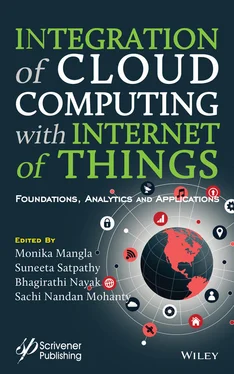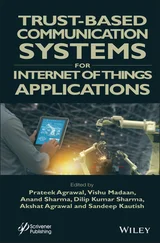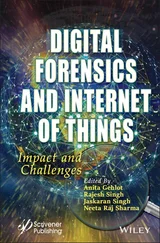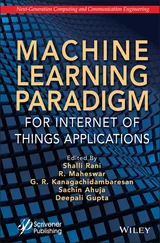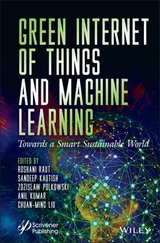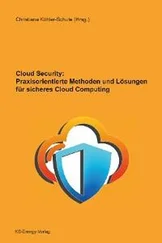1 ...7 8 9 11 12 13 ...20 
Figure 1.12Different layers of interoperability.
Table 1.2Taxonomy of interoperability: major perspectives.
| Taxonomy of interoperability |
Attributes |
| Device interoperability [19] |
Involves both the low and high-end devices High-end devices are Raspberry Pi, smartphones, etc. with good computational abilities and resources Low-end devices are low-cost sensors, actuators, RFID tags, Arduino, OpenMote, etc. with resource-crunch, communication, low energy, and processing abilities. It aims for better integration and communication among several heterogeneous devices in advanced IoT platforms. |
| Network interoperability [20] |
The network remains is multi-service, multi-vendor, largely distributed and, heterogeneous. It facilitates the better transfer of data among several smart systems using efficient networking systems. It can alleviate issues such as addressing, resource optimization, routing, security, QoS, mobility support, etc. |
| Syntactical interoperability [21] |
It allows interoperation of the format and structure of the data during communication among heterogeneous IoT devices, entities, domains, systems, etc. It includes the syntactic set rules in the same or some different grammar It is significant in the case of disparities between the encode and decode rules involving the source and the end-user. |
| Semantic interoperability [22] |
It allows the meaningful exchange of knowledge and information among agents, services, and applications. It is significant when the automatic interoperation of IoT information or data models is not materialized due to the difficulties in descriptions and understandings of operational resources or procedures. |
| Platform interoperability [21] |
The need arises with the advancement of diverse and versatile operating systems, programming languages, data structures, IoT architectures, access mechanisms, etc. Different mechanisms are developed for efficient data management involving several IoT platforms. Similarly, cross-platform and cross-domain in different heterogeneous domains are addressed. |
1.5.3 Semantic Interoperability (SI) Security
The semantic IoT is considered as a black hole in a nebulous term. It must have a security policy that is comprehensive with expansive visibility. Further, several decades-old IoT technologies require be managing or segmenting effectively along with emerging technologies. For example, the oldest IoT iteration concept is to involve multi-function printers with both copying and scanning abilities. Nevertheless, the security concerned often ignores these which pose a threat to the domain as anybody can easily route or access these from a workplace or other places. The proliferation of security corresponding to smart systems can lead to potential threats to put infrastructure, or an entire city and its traffic, lighting, and power grid systems having millions of IoT users. However, as these smart systems work in the cloud, the organization can develop several usage patterns. The integration and coordination of smart IoT devices such as wired or unwired equipment, cameras, biometric access, gesture or face identification models, keypad, etc. with interoperability, it becomes possible to place the right people at a right place. For example, the huge meshing network structure present in a smart city environment warrants a robust security traffic system, secured wired or wireless sensors, parking meters, to prevent the proliferation of the IoT system. The security system must contain visibility to maintain awareness among both users and hackers. It is thus essential to make policies about IoT security regarding the locations of cameras, conceivable devices, sensors, measuring instruments, or meters to make it effective.
1.5.4 Semantic IoT vs Machine Learning
The Machine Learners (MLs) are essential components in the field of pattern recognition, classification, and regression analysis. Over the years, several MLs have been efficiently applied in the field of power management, speech, and speaker identification, emotion recognition, etc. [28–32]. The integration and coordination of SIoT with MLs has been often discussed in the literature involving pervasive and ubiquitous computing, ambient intelligence, wireless sensor networks, artificial intelligence, human–computer interaction, cognitive science, etc. The multi-layered back-propagating Neural Networks have been effectively utilized to identify human movements such as sitting, walking, running, etc. in smart home applications. Similarly, identification ML models such as the Naive Base Classifiers, Bayesian networks, Support Vector Machines, K-Nearest Neighbor, Hidden Markov Model, etc. have been efficiently applied in the field of context-aware search systems, home automation, navigation systems, etc. in IoT domains.
The Integration and coordination of SIoT and MLs arguably increase the financial health of an industry or business. It requires the choice of specific words or vocabularies to suitably represent a set of concepts. The choice aims to bridge the semantic gap that exists among machines in IoT platform. However, many industries in the existing structure act superficially, thus unable to transform the company into a true profit-oriented entity in reality. For example, the inclusion of Artificial Intelligence in a fast-food chain allows the planning of the diet charts based on the recommendation of user habits. It helps to suggest add-on items based on the current selection, the restaurant traffic, or environmental conditions, weather, or time of a day. The integration of artificial intelligence, SIoT, machine learning, modern analytic models, etc. requires to be embedded with the lifecycle of a customer frequently and completely. For example, the satisfaction level of a customer can be enhanced by displaying his or her name, preferences, frequent visits, etc. on the menu chart makes the client feel proud and special. Efficient handling of a customer’s behaviors, interests, and future intentions can provide many intelligent inputs to the food industry in real-time. Similarly, the AI-powered chat-bouts help the customers with the user-friendly experience to boost revenue due to personalization. It has been observed that most of the consumers are motivated to choose a product of a company that recognizes, remembers, and values his or her association with the product. This way, it is possible to predict a customer’s next move, by upgrading and feeding SI data consistently in an IoT platform. This feedback provides the simulating engines or MLs an edge for new developments in this field with better outcomes. Ultimately, the revenue increases, productivity improves, operational expenses reduced, personalization enhanced at a large scale that leads to better customer experiences. The SI automated IoT embedded machines with intelligence assists millions of smart models functioning concurrently that benefits both the customers and service providers.
Internet of Things (IoT) application in smart homes or cities, workplace, agriculture, transportation, healthcare, artificial intelligence, Cognitive Science, Blockchain, Micro-service Architecture, Robotic Process, Automation, Quantum Computing are all concepts gaining attention in recent years in public, private, and corporate worlds due to media publicity and efficacy. With its growing interest on everybody and everyday applications, it helps people enjoy self-driving cars, use wearables for efficiency and timely assistance, plan taxi services or business meetings, and so on. The IoT application domains have covered all sectors, industries, and every sphere of life today, thus thrive to boost the financial health of the world. It has begun to shape the future world with a unique perspective never seen before in the history of humanity. With these intuitions, this paper elaborates several factors concerned to IoT world that rule and dominate the world today in the current scenario.
Читать дальше
